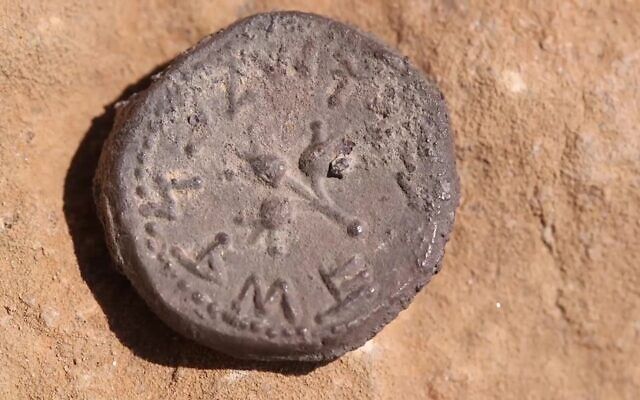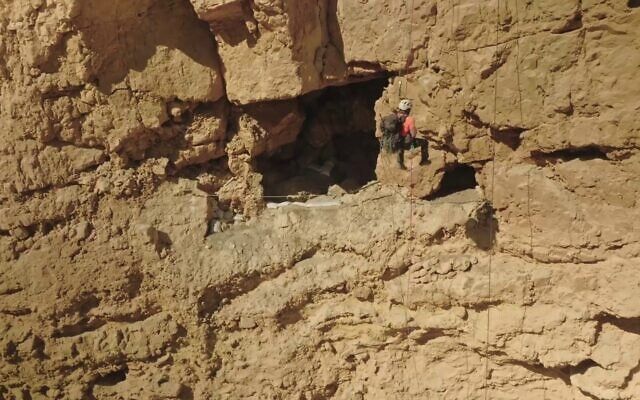Half-shekel coin from revolt against Romans
2 millennia ago uncovered in desert cave
by Melanie Lidman
July 2023
Original posting on TOI (with a short video)
https://bit.ly/half-shekel-coin

The 2,000-year-old coin as it was discovered
in a cave near Ein Gedi, with three pomegranates and
the words "Holy Jerusalem" in ancient script.
(Emil Aladjem/IAA)
Hebrew coin minted by rebels as part of underground Jewish economy and used to pay tax at Temple in Jerusalem is discovered during six-year survey mapping area of Dead Sea Scrolls
While on the search for more Dead Sea Scrolls, inspectors surveying Israel's desert caves recently discovered a rare half-shekel coin from 66 or 67 CE, the first year of the Jewish Revolt against the Romans. The currency was part of an underground Jewish economy during the rebellion's four years, the Israel Antiquities Authority announced on Tuesday.
The coin was engraved with the words "Holy Jerusalem," using ancient Hebrew script rather than the vernacular Greek of the time, in a defiant nod to their Jewish identity and the decision to mint the coins autonomously, explained Yaniv David Levy, a numismatic scholar with the Israel Antiquities Authority.
"For almost 200 years, people made the pilgrimage by foot and used silver coins for paying a tax called the ‘half-shekel tax,'" said Levy. "And apparently these coins were used for tax in the Temple and also the internal economy during the revolt."
The decision to autonomously mint coins during the rebellion was a political statement and an expression of national identity, the IAA said. At the time, the authority to mint coins was held only by the Roman emperor, and almost always featured the image of the ruling emperor and animals.
The coins minted by the Jewish rebels bear a depiction of three pomegranates. The other side of the coin features a chalice, similar to what could have been used by the priests in the Holy Temple, the words "half-shekel," and the letter aleph, denoting the first year of the revolt against the Romans.
"Apparently there was a rebel who roamed the desert cliffs, and he dropped the precious shekel treasure, and luckily we were able to find it 2,000 years later and bring it back to the public," said Hagay Hamer, an archaeologist with the IAA's Judean Desert Survey. "There are people who preserve the custom [of paying a half-shekel of taxes to the Temple] until this day and fulfill it as a mitzvah," or commandment.

Yaniv David Levy, a numismatic scholar
with the Israel Antiquities Authority, displays the 2,000-year-old coin
from the first year of the Jewish revolt.
(Emil Aladjem/IAA)
IAA inspectors discovered the coin in the area around the Ein Gedi oasis during an intensive survey of all of Israel's caves in the Judean desert, in an attempt to discover and document archaeological finds before they are stolen by looters - especially additional Dead Sea Scrolls. Inspectors have spent the past six years canvassing the caves, both by foot and by rappelling down steep cliffs to reach caves tucked into the mountainside. The survey is a joint initiative from the Israel Antiquities Authority, the Ministry of Heritage, and the Civil Administration Archaeology Unit in Judea and Samaria.
"Over the six years of the project, we have recorded over 800 caves, and have found thousands of significant finds," said Amir Ganor, the director of the Judean Desert Survey and Excavation Project. "Were it not for the survey, the coin may have been found by antiquity looters and sold on the antiquity market for the highest price offered."

Hagay Hamer, an archaeologist with the
IAA's Judean Desert Survey, rappels down a cliff
to explore a desert cave.
(Emil Aladjem/IAA)
Prior to the revolt and the decision to mint their own coins, early Jews paid the half-shekel tax using coins minted in Tyre, in Lebanon, using fine silver, Levy said. During the revolt, the Jews created shekel, half-shekel, and quarter-shekel coins from silver and bronze, inscribed with the year of the revolt.
Last year, archaeologists discovered other half-shekel coins from this period in Jerusalem and the West Bank. A Hebrew University excavation discovered one coin in the Ophel site in Jerusalem's Old City, an area that has previously revealed a number of bronze coins from the later part of the revolt.
Archaeologists from Bar Ilan University discovered an additional half-shekel coin, dating from the second year of the revolt against the Romans, in the Khirbat Jib'it archaeological site, just south of the West Bank town of Duma.

Experts clean the 2,000-year-old coin
from the Jewish revolt that was part of
an underground Jewish economy.
(Emil Aladjem/IAA)
The IAA announced the coin's discovery just before Israel enters into the Jewish fast day of Tisha B'av, which begins Wednesday evening. The day of mourning, one of the most somber days on the Jewish calendar, commemorates, among other things, the Roman destruction of the Temple in Jerusalem and the internal strife and hatred within the Jewish community that contributed to that destruction, according to tradition.
"The find of the coin at these times is a reminder for us of what happened in the past, teaching us the importance of working toward unity," said Eli Escusido, the director of the Israel Antiquities Authority.
 Why Aliyah?
Why Aliyah?